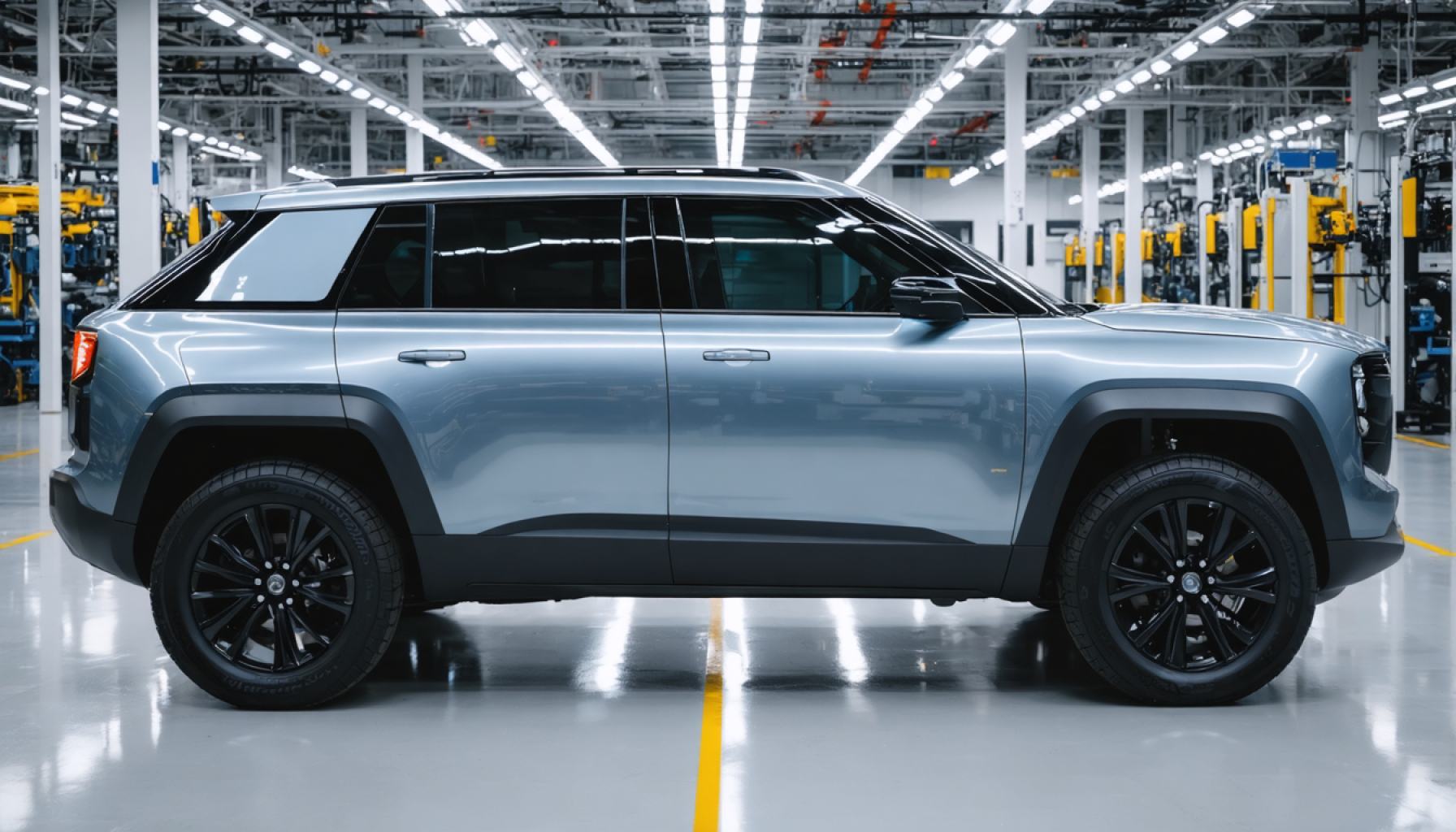- Rivian’s production facility in Normal, Illinois, produced 14,611 vehicles in three months, including the R1T, R1S, and an Electric Delivery Van for Amazon.
- A significant issue is the substantial inventory of nearly 6,000 vehicles without buyers.
- The company experienced a 36% decline in deliveries compared to the previous year, despite increased production.
- Rivian remains committed to its goal of delivering 46,000 to 51,000 vehicles by 2025, despite the current delivery-production gap.
- Possible reasons for unsold inventory include market saturation, supply chain disruptions, and shifting consumer preferences.
- Success in the electric vehicle market requires aligning production with consumer demand, a challenge Rivian must address to meet future targets.
Nestled in the quiet town of Normal, Illinois, a storm is brewing within Rivian’s production facility. Once a beacon of efficiency, the plant has now become a symbol of the perplexing challenges facing the electric vehicle startup. Over the course of just three months, the once-vacant factory arm has churned out 14,611 vehicles, including the robust R1T pickup, the sleek R1S SUV, and the utilitarian Electric Delivery Van tailored for Amazon. Yet, amid this mechanical symphony, an unsettling chorus emerges: nearly 6,000 of these vehicles remain without buyers.
What seemed like a triumph in the first quarter of 2024, with vehicles flying off production lines only to be quickly greeted by eager new owners, now feels like a distant echo. However, this year paints a different picture. The staggering 36% decline in deliveries compared to the previous year has left analysts scratching their heads. Despite a production count surpassing the previous year’s numbers, the harrowing truth is that a significant 8,640 vehicles skimmed by without finding homes.
Rivian’s ambitions remain undeterred, echoing bold plans for the future. The automaker nonchalantly reaffirms its target to deliver 46,000 to 51,000 vehicles by 2025. This bold declaration stands in sharp contrast to their Q1 results, with the gap between produced and delivered vehicles looming large like an elephant in the room. Surprisingly, in the concise press release that followed, Rivian remained silent on this discrepancy, choosing instead to bolster confidence through reaffirmed goals and upcoming earnings calls.
At the heart of this conundrum lies a question as electrifying as the vehicles themselves: why the disparity? Some speculate that market saturation, supply chain disruptions, or even shifting consumer preferences could be the culprits. Others wonder if this discordance reflects broader challenges within the rapidly evolving electric vehicle industry.
The takeaway here is both simple yet profound: In the race to lead the electric vehicle market, producing vehicles is only half the journey—regaining the pulse of the consumer remains paramount. As Rivian’s factory gears up for the ambitious targets of tomorrow, it must first navigate the intricate dance of matching production prowess with genuine demand today.
Rivian’s Road to Resilience: Navigating Demand Dynamics in the EV Industry
Understanding Rivian’s Production and Delivery Discrepancy
Rivian’s production facility in Normal, Illinois, has been a focal point of innovation and optimism within the electric vehicle (EV) industry. However, recent figures reveal unexpected challenges for the startup. Between January and March 2024, the plant produced 14,611 vehicles, including the R1T pickup, R1S SUV, and Electric Delivery Van for Amazon. Yet, a surprising 36% decline in deliveries compared to the previous year has highlighted a chasm between production and consumer demand.
Exploration of Underlying Factors
1. Market Saturation and Shifting Preferences: As the EV market expands, competition intensifies. Established players like Tesla, new entrants, and traditional automakers transitioning to electric platforms are vying for consumer attention. This saturation could be affecting Rivian’s sales numbers.
2. Supply Chain Disruptions: Global supply chain issues continue to plague the automotive industry, affecting everything from semiconductor availability to raw material supplies. These challenges can influence production timelines and delivery efficiency.
3. Consumer Trends: There is a noticeable shift toward affordability and functionality in vehicle purchases. Consumers are becoming more selective, often weighing cost, range, and charging infrastructure against brand prestige and novelty.
4. Economic Factors: Inflation and interest rate changes are influencing consumer spending patterns, which can lead to deferred vehicle purchases.
Industry Trends and Predictions
– Market Expansion: Despite short-term delivery challenges, the global EV market is projected to grow significantly, with a compound annual growth rate (CAGR) of around 29% from 2023 to 2028 (source: Allied Market Research).
– Technological Advancements: Innovations in battery technology, like solid-state batteries, promise increased range and lower costs, potentially revitalizing consumer interest.
– Policy and Infrastructure: As governments worldwide prioritize eco-friendly policies, investments in charging infrastructure and incentives are expected to boost EV adoption.
Addressing the Disparity: Rivian’s Strategic Moves
– Enhanced Consumer Engagement: Rivian could benefit from reinforcing customer loyalty through post-sale services, enhancing user experiences, and emphasizing differentiated features.
– Flexible Production Strategies: Adapting manufacturing techniques to allow for customized vehicle options may attract niche market segments.
– Transparency and Communication: Maintaining open dialogue about production plans, challenges, and solutions can build consumer trust and resilience against market fluctuations.
Quick Tips for Potential EV Buyers
– Research Thoroughly: Consider total ownership cost, including charging infrastructure and vehicle performance in your locale.
– Stay Informed on Incentives: Government incentives can significantly reduce purchase costs. Keep an eye on policy updates.
– Evaluate Long-term Value: While initial costs can be high, assess long-term savings in fuel, maintenance, and potential tax benefits.
For further insights on Rivian and the evolving EV sector, visit Rivian.
Conclusion
Rivian’s current production and delivery challenges underscore the complex landscape of the EV market. As it aims to deliver 46,000 to 51,000 vehicles by 2025, understanding and adapting to consumer needs will be crucial. With strategic adjustments and a proactive approach, Rivian can navigate these turbulent times and continue contributing to the transition toward sustainable transportation.
